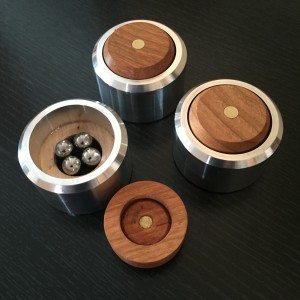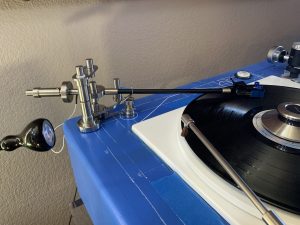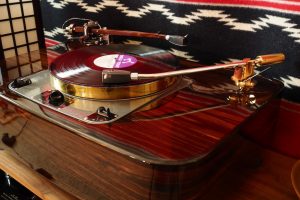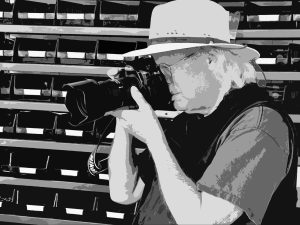The J. Sikora company was established in 2007. That's when its first turntable, the standard, was presented. It took as many as seven years to prepare the next model. When it came to it it was the top-of-the-line reference, which was introduced in 2014. In 2018 the company revealed its first tonearm, the KV12, and last year at the Warsaw Audio Video Show new and better versions were presented—the Zirconium Series line including 9" and 12" versions. We are testing the 12" version named KV12 MAX arm.
To develop the brand's own tonearm is a true challenge and achievement. Although the famous SME first produced tonearms and only years later designed decks for them, this was an absolute exception. After all, it is almost a standard for a turntable manufacturer not to have its own arms for them and use ones developed by other specialists; J. Sikora was for a long time a fan of Kuzma arms. The best and exceptionally determined turntable manufacturers, often after several years of deck production, add their own arms to the offer—let the companies Transrotor, Avid or TechDAS be an example. And, of course, J. Sikora.
In the case of this Polish manufacturer, the time it took to anchor itself in the domestic market and later to break out into global markets extended that period to eleven years. The first arm, model KV12, was presented in 2018, and we premiered it in High Fidelity at the end of that year; you can see it on our December cover (HERE).
It took four years for the manufacturer to perfect its turntable series and at the same time come up with changes that would improve something that the designers found to be a solution with clear benefits - thus the "Zirconium" series was born, from the start including two models: KV9 Max and KV12 Max. The former was premiere tested by Marek Dyba in the December issue of High Fidelity (HERE), the latter we present to you now.
J. Sikora tonearms timeline
- KV12 arm reviewed for 15th anniversary of High Fidelity
- 2018 introduction of the KV12. Distributors are pushing for a 9-inch arm to be developed as well.
- 2021 development of the KV9 arm begins
- 2022 work ends and the KV9 Max arm is ready. In its complexity, technical innovation, the design of the arm is far superior to that of the KV12 arm. Also, the cost of developing a new 9-inch arm is definitely higher. The idea arises to also create a new top-of-the-line 12-inch arm based on the design principles of the new arm (KV9 Max). And so the KV12 Max arm is developed.
- AVS 2022 premiere of the Zirconium Series tonearm line (KV9 Max and KV12 Max arms).
KV12 Max
J. Sikora tonearms are unipivot designs, i.e. supported only at one point, oil-damped. Their special feature is the material from which the arm’s tube is made. This is Kevlar, a braided polyamide fiber originally used for bulletproof vests, which has also found use in less violent products, such as the diaphragms of Bowers & Wilkins midrange drivers.
The material has all the qualities required for a tonearm: it's lightweight yet rigid. It also has, the designers say, a good distribution of resonances. Making the tube is not easy and great precision is needed to avoid fraying the material. Inside it is filled with foam in which an opening is left for wiring. And the latter has long been coming from another Polish company, Soyaton. Julian Soja makes them using 6N pure OCC copper coated with gold. Each individual wire is routed inside a Teflon tube and, without solder, routed out as a rather thick but flexible cable. The connectors are Bullet Plug type designs made of pure silver, that is, with the ground pin draining at a single point.
A few simple words...
Julian Soja Soyaton owner, designer
From left: Julian Soja and Janusz Sikora during the 141st meeting of the Cracow Sonic Society - photo by Tomasz Lechowski.
The cooperation with J. Sikora's COMPANY came from a shared passion and love for music and (very) good sound. The first milestone of our cooperation was out first meeting I met Janusz Sikora at the Audio Video Show, I think in 2014. I bought a record clamp from him then and stuck around his room for a long time, completely enamored with the sound.
A few years later, I attended (already as a Soyaton cable manufacturer) an audio presentation in Lublin, I was invited to by Adam Czerwinski of AC Records, and I in turn invited Janusz Sikora to my place. After the meeting, Janusz took my speaker cables for testing, and shortly thereafter they became part of his private listening system. Over time, the rest of the Soyaton cabling joined in, and in the meantime we visited each other many times, listened to music and spent hour talking about music and audio.
And since, on the one hand, not all audiophiles like silver, and on the other hand, both Mr. Sikoras, i.e. Janusz (father) and Robert (son), knew and verified my cables in their private systems, they asked me if I was able to supply a wire so thin, that it could be used in a tonearm. After verifying the parameters, it turned out that I could do it - and so it began. JS.
All these elements are common to the older, still offered arms, and the newer Max Zirconium Series. What is new is the material used for the arm base. Previously, it was aluminum damped internally with cast iron. However, at one of the Audio Video Shows, Mr. Janusz Sikora presented a special version of his turntable, one featuring bronze elements. He liked the sonic result very much and the new series of arms has a base made of this material. Thanks to these changes, the tube mounting piece is now much smaller than before, as is the main counterweight. The tube itself is also smaller in diameter, thanks to the development of even better technology for making it than before. The whole arm is thus slimmer and has a lower weight.
The most important changes concern the arm bearing, at least that's what the name of the new series ("Zirconium Series") implies. After many listening tests, the designer concluded that the best possible choice was using a zirconium oxide spike in the bearing. He had used this solution before, as both the turntable's main bearing spins on a ball of this type, and the feet that uncouple the bases of J. Sikora turntables have a ball of the same material.
If the arm’s support is not made of metal we have to face the problem, which is the electrical separation of the arm and ground - zirconium oxide does not conduct electricity. The right way to ground the arm is one of the most important skills, and it takes a lot of experience to do it right so that electrical charges are quickly dissipated. In the KV12 Max, the 12" (304.8 mm) arm we are testing, another fifth wire was inserted into the arm’s tube, which connects to the headshell and grounds it.
For both arms in the Max version, a dedicated headshell was designed for a specific length so that in both cases the appropriate angle of the headshell, hence cartridge, hence stylus is achieved.
The J. Sikora arms offer all the useful adjustments and settings. In a box, made of plywood, you will find a number of counterweights (this time made of brass) of different sizes and weights, which allows you to set the VTF for—as I understand it—any cartridge. But also the counterweight itself consists of two components. One is fixed in place and allows user to adjust the azimuth, and the other one is used to adjust VTF.
Also included is a polyamide (semi-crystalline polymer) counterweight, which is screwed on the end, and is designed to immobilize the weights on the arm tube and help dampen vibrations. In general, the counterweight in the tested arm is a rather complex design. First of all, the point of gravity of the main weight is located very low, which is supposed to improve—as Mr. Janusz said at the KV12 test—the speed of the arm.
There is also an improved VTA adjustment mechanism. It allows the arm’s height to be changed "on the fly." This is one of the most precise and easier to use mechanisms of this type. Azimuth correction can be done using the screw in the main counterweight. To ensure that there are no problems with the adjustment, however, the KV12 Max arm has a classic anti-skating system made by means of a weight suspended on a line.
The arm is easy to assemble, and all parts fit together perfectly. As with the KV9 Max arm—as mentioned by Marek Dyba in his test—so with the KV12 Max, the designer emphasizes the importance of proper positioning of the wires that come out of the arm from the top of its body. Since they have a certain susceptibility, they work a bit like anti-skating. In order for everything to work as it should, you need to straighten them up so that they run vertically upward and then vertically downward.
SOUND
HOW WE LISTENED
The KV12 Max tonearm was mounted on Initial Max turntable from the same company. I compared it to the KV12 arm, which is the same length (12") but older model. I know it from many listening sessions and my test. The turntable stood on the carbon fiber top shelf of Finite Elemente Master reference Pagode Edition Mk II rack. I used a DS Audio ST-50 to clean the needle.
In the test I reached for the Miyajima Laboratory Destiny cartridge. Since I only have one copy, there must have been ten to fifteen minutes breaks between listening to both arms. The signal from the cartridge was amplified in RCM Audio Sensor Prelude IC phono preamplifier, from which the signal was forwarded via Siltech Triple Crown interconnects. I placed a Verictum X-Block passive filter on the power supply, and an active Nordost QPOINT circuit on the preamplifier (test HERE).
Records used in the test, a selection
Benny Carter, Jazz Giant, Contemporary Records/Analogue Productions AJAZ 7555, "Top 100 Jazz, 45 RPM Limited Edition #0404," 2 x 180 g, 45 rpm LP (1958/?).
Bill Evans Trio, Waltz For Debby, Riverside Records/Analogue Productions AJAZ 9399, "Top 25 Jazz, 45 RPM Limited Edition #0703," 2 x 180 g, 45 rpm LP (1961/2002).
Tsuyoshi Yamamoto Trio, Midnight Sugar, Three Blind Mice/Cisco Music TBM-23-45, "Limited Edition S/N: 0080/1000," 45 rpm, 2 x 180 g LP (1974/2004), reviewed HERE PL.
Depeche Mode, Behind The Wheel (Remix), Mute 12 BONG 15, 45 rpm maxi-SP, LP (1987).
Brendan Perry, Ark, Cooking Vinyl/Vinyl 180 VIN180LP040, 2 x 180 g LP (2010/2011).
Adam Makowicz, Blue Sapphires, AC Records 028, "Color Edition No. 042," Crystal Clear 180 g LP (2023).
As I've mentioned above, I didn't have two of the same Miyajima Laboratory Destiny cartridges, so there was a period of about 10 minutes between listening to both arms as I have to move cartridge from one to another and set it up. I had practiced this for myself a few times beforehand, but that's still a considerable amount of time separating auditions A and B. So my plan was to listen in A/B and B/A sessions several times. However, the first switch between arms was enough for the differences to be clear and unambiguous.
The new arm plays faster, plays in a more resolving way and more clearly. Which means that it also sounds like this compared to other top arms. Don’t get me wrong—the original KV12 arm is excellent in this respect. In a direct comparison, however, you can hear that it emphasizes the lower midrange a bit, and thus slows down the sound a bit. Let me repeat, it is not slow at all, because when I once compared it with the Kuzma 4Point 12" arm, the arm from Slovenia was slightly slower than KV12. These, it might seem, are not big shifts, and on some turntables they will probably not be heard as clearly as they were in my system, but they are what builds the final perception of a given product.
And the KV12 Max is just fast. That's why the brass from Benny Carter's Jazz Giant album sounded gently higher and clearer with it. The entrances of either trumpet, saxophones or trombone were better heard. Also Barney Kessel's guitar, placed in the right channel together with the drums, gained in brilliance. With the new arm, the presentation is thus, as it were, automatically more exciting. For although it's still a velvety sound, in the sense that it's without the aggressive slam, the attack from the KV12 Max is faster and therefore more intelligible.
Instruments are brought out more strongly from the background by the new arm. Which means better selectivity. But it's not about "cutting them out" from the background, nor is it about excessive separation. The point is to extract enough information so that the presentation "glues" itself together in our minds into something that, after suspension of disbelief - after all, it's a mechanical reproduction, not a live performance - we can recognize as real musicians and a real space. The Zirconium arm does it better, maybe even much better. In my career, only once, with an arm from the SAT did I get something better; this Swedish arm also went lower on the bass.
With that said, the KV12 Max arm has something about it that makes music played with it extremely enjoyable. I can hear it now, it's about a slight warming, but it's a warming similar to what you usually get with vinyl, played from even a very cheap turntable—as long as it's well put together and setup. I am sure you have heard it more than once, because it sort of "wraps" the listener in sound. It's an excellent way to receive music, it's what musicians refer to when they talk about the "warmth of vinyl," even if they don't really know what they're talking about, but—you have to know this— it is different from what is recorded on "master" tapes.
Therefore, the KV12 Max plays music a bit like as if it had been recorded not on tape, but in direct-to-disc technique. I know that Mr. Janusz Sikora is a great admirer of this type of recording and considers it better than classical. And it is in this direction that the changes in the new arm have gone. Records played with the original KV12 sound, staying with this analogy, like direct-to-two-track recordings on tape. That is, still fast, still dynamic, but with a slight calming of the highs and smoothing of the dynamics. Not by much, but still.
And that's why the Bill Evans Trio concert, recorded on June 25th 1961 at The Village Vanguard club (New York) and released on Waltz For Debby, sounded with the test arm less like a smoky pub and more like a direct feed from the stage, as if we were listening to it at the time of recording in the director's room. It was all about the amount and class of the treble. They were strong, resonant and fast. They also had high energy, both in attack and sustain, primarily through very good—that's how I read it—rendering of harmonics. But it was still "vinyl" playing, that is, somewhat silky, pleasant.
Oh, how brilliantly this worked out for the title track of Tsuyoshi Yamamoto Trio's Midnight Sugar album! The piano, itself exploding with sound, was rendered in such a way that it was clear how Yamamoto plays and what the Three Blind Mice label people liked. Also, the drum cymbals sounded stronger, but also—because that's what I'm getting at—cleaner. The KV12 plays the records brilliantly. And you can stop at it, you will be more than satisfied. Each subsequent album will put a smile on your face and a sense of money well spent and time well spent. But listen to the KV12 Max to know what can be changed, and for most of us—improved.
Because not only the treble, but also the bass benefited from this change. This was best heard with this album, as Isao Fukui's double bass was recorded both directly, through two microphones, and from the bass amplifier, through one. It was placed in an enclosed booth, but in the same studio as the other two—it's a "live in the studio" recording. So it's a bit dry, but has a perfectly rendered attack. This is probably what the producers of the album had in mind. The KV12 Max showed this aspect of playing much better, allowing the attack to be more strongly emphasized, but also showing a more resolved sound.
In fact, it was the same with music in which the bass is generated electronically, that is, the albums Behind The Wheel (Remix) by Depeche Mode and Ark by Brendan Perry. On both, the low range is really low, and incredibly energetic. But it was the KV12 Max that showed that it's not as uniform as lower class turntables and tonearms show it to be, and that it changes both in terms of dynamics, intensity, and the reverb that has been superimposed on it.
Let's listen to the beginning of Depeche Mode's maxi single and note the effect superimposed on the bass—this is the so-called "delay", which repeats the base sound in equal intervals, quieter each time. It turns out that it's quite powerful here, and it's the one that creates the big stage, not the bass itself. I talked about clarity - also here the brass sounded more open and cleaner. Gahan's vocals were shown more clearly, although they were not pushed forward which is a good thing, since he is quite far away in the mix, with quite a bit of reverb.
Very interestingly all these features came together when playing Perry's album. The tested arm sounds extremely resolving, causing previously pleasant and pleasing sounds to form entirely new constellations, as if instead of one source of light we suddenly saw several separate points. This can be disorienting for a while, as we are used to paying less attention to the events in front of us. And KV12 Max forces on us a stronger involvement, it shows a lot of information, so we need to get used to it and "re-calibrate" internally. After all, when we find a new internal harmony, we will realize that KV12 Max shows the world more accurately, more clearly, more truthfully.
Summary
The thing that stayed in my mind after the test of the KV12 Max arm is that you could listen to music with it on lower volume levels, because everything was still legible with it. I recalled earlier the comparison of tape and record, direct-to-disc and direct-to-two track techniques, so let the comparison of Test Press pressing and classic vinyl complete the trinity: the tested arm sounds more like the former.
It allows the needle to read an incredible amount of information and gives it in an extremely dynamic way. It is still at the same time a delicate arm, if you can say so, that is, not bullying the recordings, but entering into alliances with them. With it, Adam Makowicz's recently released Blue Sapphires sounded cleaner and faster than with the KV12. The older arm has its advantages, such as warmth, density and internal focus. However, the zirconium suspension arm is so resolving that I don't think any other arm I've ever tested has topped it.
And anyway, the most important thing is that you listen to the music with excitement, with curiosity. There is no room for lingering, there is action, and when needed breath, but without exaggeration. In Marek Piwowski's Rejs (1970), engineer Mamoń, played by Zdzisław Maklakiewicz, said that nothing happens in Polish film. Here, on the contrary, something is still happening. With KV12 Max even the silence carried with it some energy and made musical sense. And I guess that's what music is all about. There is no other choice but to grant it our GOLD FINGERPRINT.
Technical specifications (according to the manufacturer)
- Type: unipivot
- Materials: Kevlar, aluminum, bronze, brass, stainless steel
- Oil damping: yes
- Tube: tapered (Kevlar)
- VTA correction: yes
- Azimuth adjustment: yes
- Weight: 250 g
- VTA weight: 225 g
- Effective length: 304.8 mm
- Mounting distance: 291 mm
- Effective weight: 12.5 g
- Available colors: natural yellow, matte black
- Wiring: 24K gold plated 6N copper OCC
This test has been provided under the guidelines adopted by the Association of International Audiophile Publications, an international audio press association concerned with ethical and professional standards in our industry; High Fidelity is a founding member. You can find more about the association and its constituent titles HERE.
KV12 MAX Zirconium Series Sikora Tonearm
Price (when reviewed): 12,500 EUR
41 Poligonowa St.
20-817 Lublin POLAND.
MADE IN POLAND
Provided for test by: J. Sikora
text WOJCIECH PACUŁA
translation Marek Dyba
images Tomasz Lechowski, High Fidelity
















































